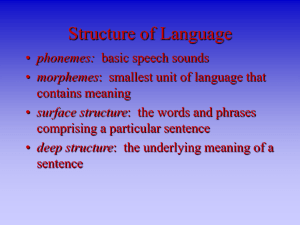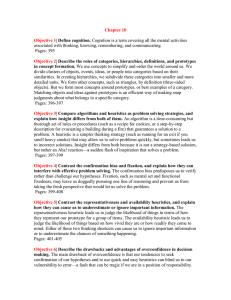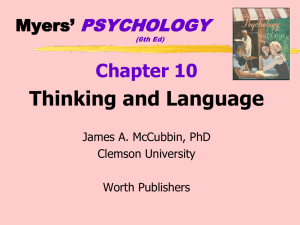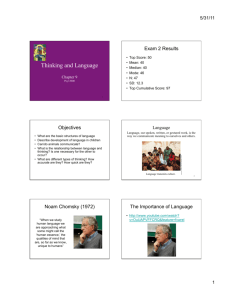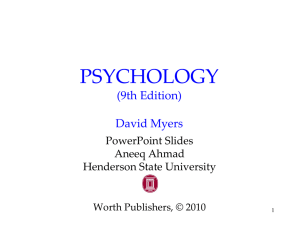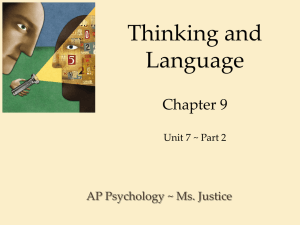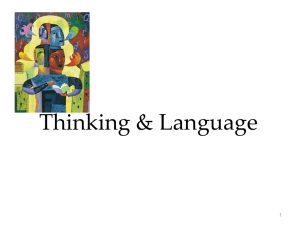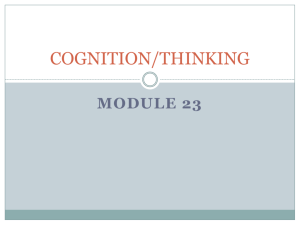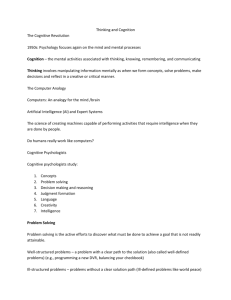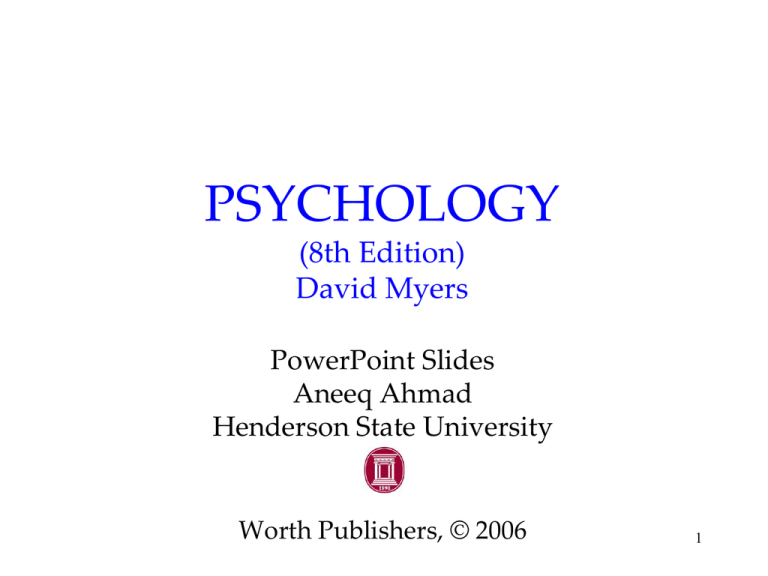
PSYCHOLOGY
(8th Edition)
David Myers
PowerPoint Slides
Aneeq Ahmad
Henderson State University
Worth Publishers, © 2006
1
Thinking and Language
Chapter 10
2
Thinking and Language
Thinking
Concepts
Solving Problems
Making Decisions and Forming
Judgments
Belief Bias
3
Thinking and Language
Language
Language Structure
Language Development
Thinking & Language
Language Influences Thinking
Thinking in Images
4
Thinking and Language
Animal Thinking and
Language
Do Animals Think?
Do Animals Exhibit Language?
The Case of the Apes
5
6
From “Problem Solving” by M. Scheerer. Copyright © 1963 by
Scientific American, Inc. All Rights Reserved.
The Matchstick
Problem: How would
you arrange six
matches to form four
equilateral triangles?
Thinking, or cognition, refers to a process that
involves knowing, understanding,
remembering, and communicating.
7
Cognitive Psychologists
Thinking involves a number of mental
activities, which are listed below. Cognitive
psychologists study these in great detail.
1.
2.
3.
4.
Concepts
Problem solving
Decision making
Judgment formation
8
Category Hierarchies
We organize concepts into category hierarchies.
9
Categories
Once we place an item in a category, our
memory shifts toward the category prototype.
Courtesy of Oliver Corneille
A computer generated face that was 70 percent
Caucasian led people to classify it as Caucasian.
10
The mental grouping of similar
objects, events, ideas, or people.
There are a variety of chairs but
their common features define
the concept of a chair.
BEST example of a concept.
11
Problem Solving
There are two ways to solve problems:
Algorithms: Methodical, logical rules or procedures
that guarantee solving a particular problem.
Heuristics: simple, thinking strategies that allow us to make
judgments and solve problems efficiently. Heuristics are less
time consuming, but more error-prone than algorithms.
•Logical rule or procedure that
guarantees solving a particular
problem
•Simple, efficient thinking
strategy that helps us make
judgments and solve problems
•Longer
•Speedy
•Less errors
•Error prone
12
How did the previous activities explain the concepts below,
use both examples.
mental set –
functional fixedness –
insight –
confirmation bias –
13
Mental Set - A tendency to approach a problem
in a particular way, especially if that way was
successful in the past.
Fixation: An inability to see a problem from a
fresh perspective. This impedes problem
solving. Two examples of fixation are mental set
and functional fixedness.
14
Functional Fixedness
A tendency to think only of the familiar
functions of an object.
?
Problem: Tie the two ropes together.
Use a screw driver, cotton balls and a matchbox.
15
Functional Fixedness
Use the screwdriver as a weight, and tie it to the
end of one rope. Swing it toward the other rope
to tie the knot.
?
The inability to think of the screwdriver as a weight is
16
functional fixedness.
Obstacles in Solving Problems
Confirmation Bias: A tendency to search for
information that confirms a personal bias.
2–4–6
Rule: Any ascending series of numbers. 1 – 2 – 3 would
comply. Ss had difficulty figuring out the rule due to a
confirmation bias (Wason, 1960).
17
The Matchstick Problem: Solution
From “Problem Solving” by M. Scheerer. Copyright © 1963 by
Scientific American, Inc. All Rights Reserved.
18
Insight
KOHLER =>Insight
involves a sudden
novel realization of a
solution to a problem.
Humans and animals
have insight.
Grande using boxes to
obtain food
19
Insight
From Mark Jung-Beekman, Northwestern
University and John Kounios, Drexel University
Brain imaging and EEG
studies suggest that
when an insight strikes
(the “Aha” experience), it
activates the right
temporal cortex (JungBeeman, 2004). The time
between not knowing the
solution and realizing it
is 0.3 seconds.
20
21
Using and Misusing Heuristics
Two kinds of heuristics, representative
heuristics and availability heuristics, have been
identified by cognitive psychologists.
Names to know!
Courtesy of Greymeyer Award, University
of Louisville and Daniel Kahneman
Courtesy of Greymeyer Award, University
of Louisville and the Tversky family
Amos Tversky
Daniel Kahneman
22
Why does our availability heuristic lead us astray?
Whatever increases the ease of retrieving
information increases its perceived availability.
Occasionally even the smartest people may make a dumb decision or give a dumb
answer
estimating the likelihood of events based on their availability in memory
if instances come readily to mind (perhaps because of their vividness), we
presume such events are common
How is retrieval facilitated?
1. How recently we have heard about the event.
2. How distinct it is.
3. How correct it is.
23
Example: airplane crash vs. driving accident
WHY?
“perceived
control”
An event’s
AVAILABILITY
to our memory
need not indicate
its likelihood in
reality.
Big losses
Small wins
Casinos entice us to gamble by signaling even small wins
with bells and lights – making them vividly memorable –
while keeping big losses soundlessly invisible.
24
Overconfidence
Intuitive heuristics, confirmation of beliefs, and
the inclination to explain failures increase our
overconfidence. Overconfidence is a tendency to
overestimate the accuracy of our beliefs and
judgments.
At a stock market, both
the seller and the buyer
may be confident about
their decisions on a
stock.
25
Exaggerated Fear
The opposite of having
overconfidence is
having an exaggerated
fear about what may
happen. Such fears may
be unfounded.
AP/ Wide World Photos
The 9/11 attacks led to a
decline in air travel due
to fear.
26
Framing
Decisions
Decisions and judgments may be
significantly affected depending
upon how an issue is framed.
•the way an issue is posed
Example:
What is the best way to market ground beef—
*as 25% fat or 75% lean?
…10% of people will die during a
particular surgery or 90% will survive?
Information is the same BUT…the effect is NOT!
27
Belief Bias
The tendency of one’s preexisting beliefs to
distort logical reasoning by making invalid
conclusions.
God is love.
Love is blind
Ray Charles is blind.
Ray Charles is God.
Anonymous graffiti
28
Belief Perseverance
Belief perseverance is the tendency to cling to
our beliefs in the face of contrary evidence.
Do risk takers or cautious people
make better firefighters? Once we’ve
formed opinions on a question like
this and developed reasons for our
views, we tend to cling to our beliefs
– even if the basis for our opinion is
undermined
If you see that a country is hostile, you are likely
to interpret their ambiguous actions as a sign of
hostility (Jervis, 1985).
29
Intuition may be perilous if unchecked, but
may also be extremely efficient and adaptive.
30
Perils & Powers of Intuition
31
Can we create a freely moving
machine with the intellectual
capabilities of a human being????
Artificial Intelligence
– designing and
programming
computer systems /
robots
• to do intelligent
things
• to simulate human
thought processes
– intuitive
reasoning
– learning
– understanding
language
Computer Neural Networks
• computer circuits that mimic the
brain’s interconnected neural cells
=>excitatory or inhibitory
messages that fire when the
signal strength reaches a certain
threshold
• performing tasks
• learning to
recognize visual
patterns
32
• learning to recognize smells
IBM and the Jeopardy Challenge
33
1. In what state does she live?
2. How many cats does she have?
3. When going to the library, would she go by bus or by
car?
4. Does she wear glasses?
5. How old is she?
6. How many brothers and sisters does she have?
7. What is her motto?
8. What is her occupation?
Explain what you used to figure out what her
occupation was. Why did you pick what you
picked?
34
35
Language
Language, our spoken, written, or gestured work,
is the way we communicate meaning to ourselves
and others.
M. & E. Bernheim/ Woodfin Camp & Associates
Language transmits culture.
36
These letters represent
phonemes or the smallest
distinctive sound units in spoken
language!
You are
“undesirable!”
Don’t argue
over
semantics!
MEANING
Morphemes = smallest unit that
carries meaning (prefix / suffix)
Grammar = a
system of rules
used in language!
37
Critical Thinking Thoughts/ Questions:
Language Structure
Phonemes: The smallest distinct sound unit in a
spoken language. For example:
bat, has three phonemes b · a · t
chat, has three phonemes ch · a · t
39
Language Structure
Morpheme: The smallest unit that carries a
meaning. It may be a word or part of a word.
For example:
Milk = milk
Pumpkin = pump . kin
Unforgettable = un · for · get · table
40
Structuring Language
Phonemes
Basic sounds (about 40) … ea, sh.
Morphemes
Smallest meaningful units (100,000)
… un, for.
Words
Meaningful units (290,500) … meat,
pumpkin.
Phrase
Composed of two or more words
(326,000) … meat eater.
Sentence
Composed of many words (infinite)
… She opened the jewelry box.
41
Grammar
Grammar is the system of rules in a language
that enable us to communicate with and
understand others.
Grammar
Semantics
Syntax
42
Semantics
Semantics is the set of rules by which we derive
meaning from morphemes, words, and
sentences. For example:
Semantic rule tells us that adding –ed to the
word laugh means that it happened in the past.
43
Syntax
Syntax consists of the rules for combining
words into grammatically sensible sentences.
For example:
In English, syntactical rule says that adjectives
come before nouns; white house. In Spanish, it is
reversed; casa blanca.
44
Language
Development
Language Predisposition
Deals with language, development, and research methodology; provides a good demonstration of human
sound recognition abilities.
Time Life Pictures/ Getty Images
Children learn their
native languages much
before learning to add
2+2.
We learn, on average
(after age 1), 3,500 words
a year, amassing 60,000
words by the time we
graduate from high
school.
Infant Speech Sound
Discrimination
Demonstrates how infants can
discriminate between subtle
sound differences; focuses largely
on infant speech development.
45
Goo goo!
GOO GOO!
DUDE!
Language
Baby talk video
click here
Summary of Language Development
Month
(approximate)
Stage
4
Babbles many speech sounds.
10
Babbling reveals households
language.
12
One-word stage.
24
Two-world, telegraphic speech.
24+
Language develops rapidly into
complete sentences.
“Bugs Bunny”
Means I want to pet the bunny rabbit.
46
When do we learn language?
When to Worry if a Child Has Too Few Words NY Times
Longer phrases: After telegraphic speech,
children begin uttering longer phrases (Mommy
get ball) with syntactical sense, and by early
elementary school they are employing humor.
You never starve in the desert because of all the
sand-which-is there.
47
“Sign Language & the Brain”
Human Language: Signed and Spoken
• Please read “Sign Language & the Brain” in
the SCIENTIFIC AMERICAN –
Psychology reader pgs 32-39.(new psych
reader)
• Please “make your own notes” on the
reading! But not on the article itself.
Article is linked to class website!
48
Explaining Language Development
nature vs. nurture ...once again!
Language develops w/ familiar
learning principles…association,
imitation, reinforcement. “Verbal
behavior evidently came into
existence when, through a critical
step in evolution, the vocal
muscles became susceptible to
OPERANT CONDITIONING.”
SKINNER
49
Explaining Language Development
I oppose Skinner’s idea. I think that
language is genetic. We come pre-wired
w/ a LAD…language acquisition
device, which helps to develop our
inborn universal grammar…It works
like this…as children experience
language, grammar switches are
thrown w/ in their brain.
Inborn Universal Grammar
CHOMSKY
50
Explaining Language Development
Statistical learning.. gradual
changes in network connections
based on experience. Given
training through exposure to many
language examples, a neuron-like
network can learn a language’s
statistical structure i.e. past,
present etc.
COGNITIVE NEUROSCIENTISTS
Patricia Kuhl:
The linguistic
genius of babies
51
COGNITIVE NEUROSCIENTISTS…continued
Statistical Learning and Critical Periods: Well
before our first birthday, our brains are
discerning word breaks by statistically
analyzing which syllables in hap-py-ba-by go
together. These statistical analyses are
learned during critical periods of child
development.
52
Genes, Brain, & Language
David Hume Kennerly/ Getty Images
Genes design the mechanisms for a
language, and experience modifies the brain.
53
Young children have a readiness
to learn language. 10 years after
coming to the US, Asian
immigrants took a grammar test.
Those who arrived before age 8
understood grammar as well as
native speakers. Those who
arrived later did not.
54
Language Theories
and its affect on thinking
language determines the way we think
LANGUAGE RELATIVITY
OR
LINGUISTIC DETERMINISM
language shapes a man’s basic ideas
“learn a language and you can
learn about a culture”
“to destroy a people,
destroy their language”
poet Joy Harjo
Benjamin Lee Whorf
The more words in a
language, the more
complex the society.
55
** To expand language is to expand the ability to think =>
Language
thinking develops hand in hand with language
The interplay
of thought
and language
The traffic runs
both ways b/w
thinking and
language. Thinking
affects our
language, which
affects our thought.
We often think in images => “VISUALIZATION”
• artists, athletes, scientists, poets
•Mathematicians, Students
Stance, see the ball,
location of wrists, elbow,
shoulders, feet
placement, squeeze
torso, hips through the
zone…….
56
Language Influences Thinking
When a language provides words for objects or events,
we can think about these objects more clearly and
remember them. It is easier to think about two colors
with two different names (A) than colors with the same
name (B) (Özgen, 2004).
57
Linguistic Determinism Questioned
Although people from Papua New Guinea do
not use our words for colors and shapes, they
still perceive them as we do (Rosch, 1974).
58
Thinking in Images
To a large extent thinking is language-based.
When alone, we may talk to ourselves. However,
we also think in images.
We don’t think in words, when:
1. When we open the hot water tap.
2. When we are riding our bicycle.
59
Images and Brain
Imagining a physical activity activates the same
brain regions as when actually performing the
activity.
Jean Duffy Decety, September 2003
60
Kohler proved that
Chimps have insight!
There is more to learning
than conditioning.
Dance of the HONEYBEE
*the straight-line part of the dance points in the
direction of the nectar source relative to the sun;
the duration of the dance indicates distance. The
other bees, who can’t see the dance in the dark
hive, huddle close to feel what is going on.
61
Insight
Chimpanzees show insightful behavior when
solving problems.
Sultan uses sticks to get food.
62
Do Animals Think?
Common cognitive skills
in humans and apes
include the following:
Concept formation.
Insight
Problem Solving
Culture
Mind?
William Munoz
1.
2.
3.
4.
5.
African grey parrot assorts red
blocks from green balls.
63
Problem Solving
Courtesy of Jennifer Byrne, c/o Richard Byrne,
Department of Psychology, University of St. Andrews, Scotland
Apes are famous,
much like us, for
solving problems.
Chimpanzee fishing for ants.
64
Animal Culture
Animals display customs and culture that are
learned and transmitted over generations.
Michael Nichols/ National Geographic Society
Copyright Amanda K Coakes
Dolphins using sponges as
forging tools.
Chimpanzee mother using and
teaching a young how to use
a stone hammer.
65
Mental States
Can animals infer mental states in themselves
and others?
To some extent. Chimps and orangutans (and
dolphins) used mirrors to inspect themselves
when a researcher put paint spots on their faces
or bodies.
66
Do Animals Exhibit Language?
Animals and Language Video
There is no doubt that animals communicate.
Copyright Baus/ Kreslowski
Vervet monkeys, whales and even honey bees
communicate with members of their species
and other species.
Rico (collie) has a
200-word vocabulary
67
The Case of Apes
Chimps do not have a vocal apparatus for
human-like speech (Hayes & Hayes,1951).
Therefore, Gardner and Gardner (1969) used
American Sign Language (ASL) to train
Washoe, a chimp, who learned 182 signs by the
age of 32.
Washoe, a Chimp of Many Words, Dies at 42
68
Gestured Communication
Animals, like humans, exhibit communication
through gestures. It is possible that vocal speech
developed from gestures during the course of
evolution.
For hearing people, today’s gestures may
be less central to communication than for
those who first used hand signals. Yet
gestures remain naturally associated with
spontaneous speech, especially speech that
has spatial content.
69
Sign Language
American Sign Language (ASL) is
instrumental in teaching chimpanzees a
form of communication.
Paul Fusco/ Magnum Photos
When asked, this chimpanzee uses
a sign to say it is a baby.
70
Computer Assisted Language
Others have shown that bonobo pygmy chimpanzees can
develop even greater vocabularies and perhaps semantic
nuances in learning a language (Savage-Rumbaugh,
1991). Kanzi and Panbanish developed vocabulary for
hundreds of words and phrases.
Copyright of Great Ape Trust of Iowa
71
Criticism
1.
2.
3.
4.
Apes acquire their limited vocabularies with a
great deal of difficulty, unlike children who
develop vocabularies at amazing rates.
Chimpanzees can make signs to receive a
reward, just as a pigeon who pecks at the key
receives a reward. However, pigeons have not
learned a language.
Chimpanzees use signs meaningfully but lack
syntax.
Presented with ambiguous information, people
tend to see what they want to see.
72
Conclusions
If we say that animals can use meaningful
sequences of signs to communicate a capability
for language, our understanding would be
naive… Steven Pinker (1995) concludes, “chimps
do not develop language.”
73
Things to know:
1. Be able to apply your learning!!!
2. VOCAB – prototype, framing, OVERCONFIDENCE, heuristics,
functional fixedness, phonemes, morphemes, semantics, syntax etc.
(there are many more!), situations which need application of vocab
terms / ideas etc.this is the bulk of the test!
3. availability heuristics vs. representative heuristics
4. language development stages / characteristics
5. Whorf, Chomsky, Skinner, Cog Neuroscience/ statistics
**Prior chapter material


